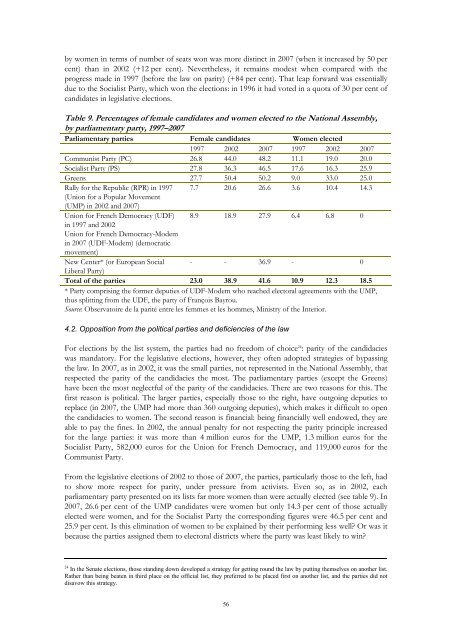Electoral gender quotas systems and their implementation in Europe
Electoral gender quotas systems and their implementation in Europe
Electoral gender quotas systems and their implementation in Europe
Create successful ePaper yourself
Turn your PDF publications into a flip-book with our unique Google optimized e-Paper software.
y women <strong>in</strong> terms of number of seats won was more dist<strong>in</strong>ct <strong>in</strong> 2007 (when it <strong>in</strong>creased by 50 percent) than <strong>in</strong> 2002 (+12 per cent). Nevertheless, it rema<strong>in</strong>s modest when compared with theprogress made <strong>in</strong> 1997 (before the law on parity) (+84 per cent). That leap forward was essentiallydue to the Socialist Party, which won the elections: <strong>in</strong> 1996 it had voted <strong>in</strong> a quota of 30 per cent ofc<strong>and</strong>idates <strong>in</strong> legislative elections.Table 9. Percentages of female c<strong>and</strong>idates <strong>and</strong> women elected to the National Assembly,by parliamentary party, 1997–2007Parliamentary parties Female c<strong>and</strong>idates Women elected1997 2002 2007 1997 2002 2007Communist Party (PC) 26.8 44.0 48.2 11.1 19.0 20.0Socialist Party (PS) 27.8 36.3 46.5 17.6 16.3 25.9Greens 27.7 50.4 50.2 9.0 33.0 25.0Rally for the Republic (RPR) <strong>in</strong> 1997 7.7 20.6 26.6 3.6 10.4 14.3(Union for a Popular Movement(UMP) <strong>in</strong> 2002 <strong>and</strong> 2007)Union for French Democracy (UDF) 8.9 18.9 27.9 6.4 6.8 0<strong>in</strong> 1997 <strong>and</strong> 2002Union for French Democracy-Modem<strong>in</strong> 2007 (UDF-Modem) (democraticmovement)New Center* (or <strong>Europe</strong>an Social - - 36.9 - 0Liberal Party)Total of the parties 23.0 38.9 41.6 10.9 12.3 18.5* Party compris<strong>in</strong>g the former deputies of UDF-Modem who reached electoral agreements with the UMP,thus splitt<strong>in</strong>g from the UDF, the party of François Bayrou.Source: Observatoire de la parité entre les femmes et les hommes, M<strong>in</strong>istry of the Interior.4.2. Opposition from the political parties <strong>and</strong> deficiencies of the lawFor elections by the list system, the parties had no freedom of choice 24 : parity of the c<strong>and</strong>idacieswas m<strong>and</strong>atory. For the legislative elections, however, they often adopted strategies of bypass<strong>in</strong>gthe law. In 2007, as <strong>in</strong> 2002, it was the small parties, not represented <strong>in</strong> the National Assembly, thatrespected the parity of the c<strong>and</strong>idacies the most. The parliamentary parties (except the Greens)have been the most neglectful of the parity of the c<strong>and</strong>idacies. There are two reasons for this. Thefirst reason is political. The larger parties, especially those to the right, have outgo<strong>in</strong>g deputies toreplace (<strong>in</strong> 2007, the UMP had more than 360 outgo<strong>in</strong>g deputies), which makes it difficult to openthe c<strong>and</strong>idacies to women. The second reason is f<strong>in</strong>ancial: be<strong>in</strong>g f<strong>in</strong>ancially well endowed, they areable to pay the f<strong>in</strong>es. In 2002, the annual penalty for not respect<strong>in</strong>g the parity pr<strong>in</strong>ciple <strong>in</strong>creasedfor the large parties: it was more than 4 million euros for the UMP, 1.3 million euros for theSocialist Party, 582,000 euros for the Union for French Democracy, <strong>and</strong> 119,000 euros for theCommunist Party.From the legislative elections of 2002 to those of 2007, the parties, particularly those to the left, hadto show more respect for parity, under pressure from activists. Even so, as <strong>in</strong> 2002, eachparliamentary party presented on its lists far more women than were actually elected (see table 9). In2007, 26.6 per cent of the UMP c<strong>and</strong>idates were women but only 14.3 per cent of those actuallyelected were women, <strong>and</strong> for the Socialist Party the correspond<strong>in</strong>g figures were 46.5 per cent <strong>and</strong>25.9 per cent. Is this elim<strong>in</strong>ation of women to be expla<strong>in</strong>ed by <strong>their</strong> perform<strong>in</strong>g less well? Or was itbecause the parties assigned them to electoral districts where the party was least likely to w<strong>in</strong>?24 In the Senate elections, those st<strong>and</strong><strong>in</strong>g down developed a strategy for gett<strong>in</strong>g round the law by putt<strong>in</strong>g themselves on another list.Rather than be<strong>in</strong>g beaten <strong>in</strong> third place on the official list, they preferred to be placed first on another list, <strong>and</strong> the parties did notdisavow this strategy.56






